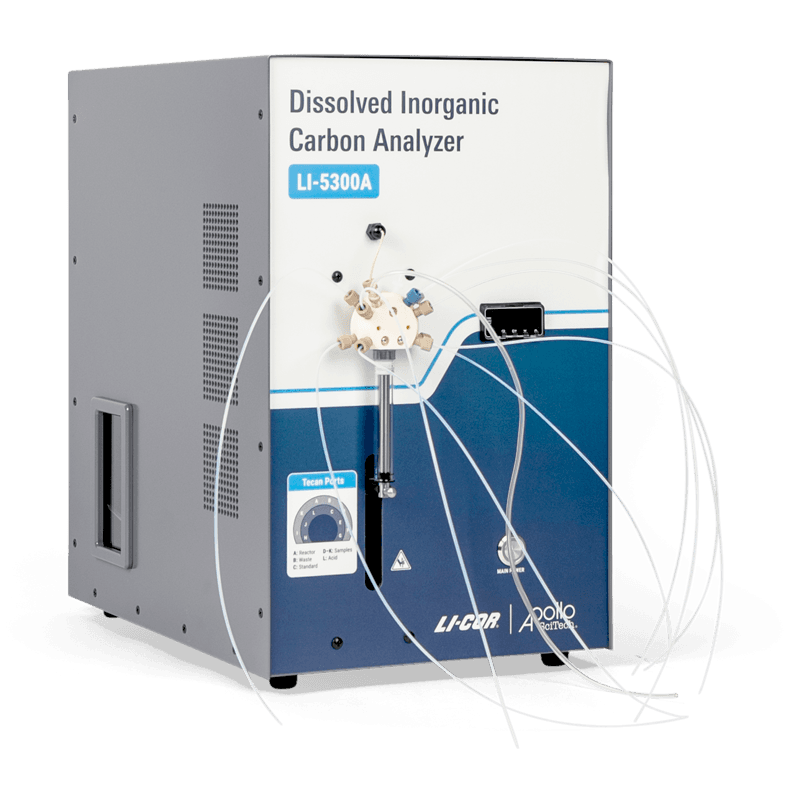NEW Dissolved Inorganic Carbon Analyzer
Characterize inorganic carbon in an aquatic carbonate system
Get a Quote
Why Measure Dissolved Inorganic Carbon (DIC)?
DIC measurements help researchers better understand the role of aquatic systems in the global carbon cycle—especially in the context of ocean acidification and climate change. DIC measurements provide insights into carbon behavior—such as carbon sources, sinks, and fluxes.
DIC and the corresponding isotopic δ13C signature measurements benefit research disciplines including:
- Ocean acidification
- Climate change
- Geochemical-based carbon cycle research
- Carbon behavior in a water column
- Porewater from sediment cores
- Calculation of carbonate parameters
- Algae applications (e.g., algae biofuels)
- Net productivity measurements
- Carbon dioxide removal and sequestration
- Oil and gas industry applications
What is DIC?
When carbon dioxide (CO2) gas dissolves in water, it forms carbonic acid (H2CO3), which then dissociates into various constituents—including protons (H+), bicarbonate ions (HCO3-), and carbonate ions (CO32-). Dissolved inorganic carbon (DIC) is the combined total of these carbon containing species expressed as a CO2 equivalent concentration. The concentrations of each constituent can be influenced by the system's pH, partial pressure of CO2 (pCO2), and total alkalinity. Figure 1 shows how the balance between carbonic acid, carbonate, and bicarbonate is affected by pH.

Advantages of the DIC System
- Takes precise measurements across a wide range of values
- Can extract 100% of CO2 from water samples in 2 minutes
- Stationary on ships and laboratories
- Suited for culturing and incubation measurements
How is it Measured?
LI-5300A
Each DIC analyzer includes a required secondary gas analyzer. The LI-7815 CO2/H2O Trace Gas Analyzer is ideal for precise seawater measurements.
The DIC analyzer and gas analyzer work in tandem to accurately measure DIC in a water sample. The DIC analyzer is composed of a Tecan XLP6000 syringe pump, a 12-port valve system, a Peltier condenser, a mass flow controller, and a computer with proprietary software for data collection and analysis.
LI-5350A
Each DIC analyzer includes a required secondary gas analyzer. The LI-850 CO2/H2O Analyzer is ideal for precise freshwater measurements, but sacrifices precision to achieve a more compact form factor
All DIC configurations consist of core module which contains a reactor, syringe pump, sample selection valve, and sample conditioning. An external computer is included with proprietary software for data collection and analysis. The LI-5350A is the only one with an internally mounted gas analyzer.
LI-5370A
The DIC analyzer acidifies a water sample in a reactor which forces all inorganic carbon species into gas phase CO2. That CO2 is swept from the reactor by a carrier gas and is carried to a CO2 analyzer. The CO2 measurements are totalized to compute total DIC, along with the δ13C ratio in the LI-5370A. Total DIC measurements are reported in μmol/L or μM. Measurements of calibration standards for DIC (and δ13C for LI-5370) are interspersed with sample measurements to ensure overall measurement accuracy.
The LI-5370A is supplied with an external gas analyzer, as well as the core module which contains a reactor, syringe pump, sample selection valve, and sample conditioning. An external computer is also included with proprietary software for data collection and analysis.
For more details about each combination of DIC and gas analyzer, see the chart below:
DIC Systems from LI-COR
| DIC Analyzer | Measured Parameters | Precision (1σ) |
|---|---|---|
| LI-5300A DIC Analyzer with LI-7815 | Total DIC | 0.1% @ 2000 umol/L |
| LI-5350A DIC Analyzer with LI-850 | Total DIC | 0.15%@ 2000 umol/L |
| LI-5370A Isotopic Dissolved Inorganic Carbon DIC Analyzer with LI-7825 | Total DIC and δ13C DIC | 0.15% @ 2000 umol/L |
The DIC analyzer uses a method that acidifies a water sample to release CO2 gas and allow for the detection and quantification of the evolved CO2. The acidification process forces all inorganic carbon species into the gas phase as CO2—which allows the gas analyzer to then quantify CO2.
These gas measurements, in conjunction with sample data, are then used to compute the water sample's DIC concentration. All DIC measurements are reported in μmol/L.
Specifications
General
- Power supply: 100 to 240 VAC 50/60 Hz
- Power requirements:
- DIC Module: 120W max
- External Computer: 95W max
- Gas Analyzer: LI-7815/LI-7825 65W max; LI-850 14W max
- Computer operating system: Windows® 10 (included)
- Number of Sample Ports: 8
- Operating environment: Indoor
- Operating temperature: 15 to 28°C recommended. Temperature fluctuations may affect measurement precision.
- Operating humidity: Up to 85%, non-condensing
- Dimensions: 43 x 27 x 47 cm (H x W x D) not including externally mounted gas analyzer or computer
LI-5300A
- Gas analyzer: LI-7815; included; externally mounted
- Carrier gas: Compressed air with constant CO2concentration; regulated between 16 and 18 PSI
- Precision (1σ): ± 0.1% at 2000 μmol/L
- Accuracy: Determined by uncertainty of calibration standards and precision
- Measurement time: ~ 4 minutes per measurement
- Sample volume1,2: 0.5 to 4 mL per measurement
LI-5350A
- Gas analyzer: LI-850; included; internally mounted
- Carrier gas: CO2-free compressed air or N2; regulated between 16 and 18 PSI
- Precision (1σ): 0.15% at 2000 μmol/L
- Accuracy: Determined by uncertainty of calibration standards and precision
- Measurement time: ~ 4 minutes per measurement
- Sample volume 1,2: 0.2 to 1.5 mL per measurement
LI-5370A
- Gas analyzer: LI-7825; included; externally mounted
- Carrier gas: Compressed air with constant CO2concentration; regulated between 16 and 18 PSI
- Precision (1σ): 0.1% at 2000 μmol/L
- Precision δ13C (1σ): ± 0.04%
- Accuracy: Determined by uncertainty of calibration standards and precision
- Measurement time: ~ 4 minutes per measurement
- Sample volume1,2: 0.5 to 4 mL per measurement
Specifications subject to change without notice.
References
Dickson, A., C. Goyet (1994). DOE Handbook of Methods for the Analysis of the Various Parameters of the Carbon Dioxide System in Sea Water, Version 2.
Dive deeper into your research.
Get a Quote